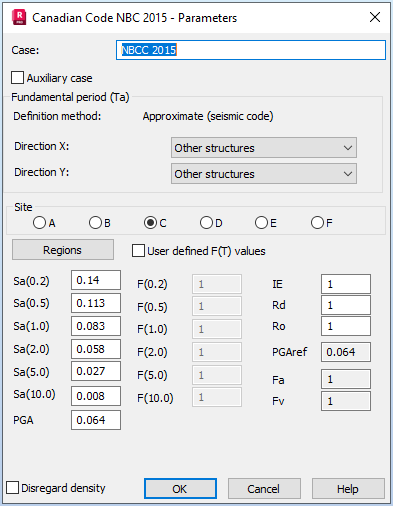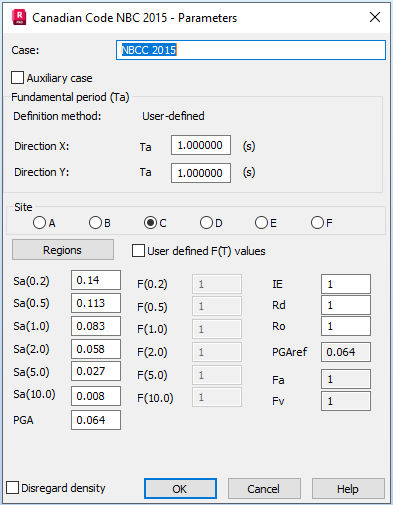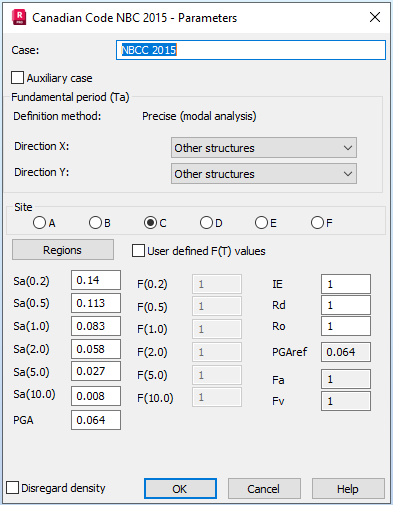The parameters of the seismic simplified analysis according to the equivalent lateral force method depend on a seismic code and a method of defining the values of the fundamental periods selected in the Seismic Analysis dialog.
- Braced frames.
- Coupled walls.
- Other frames (other moment resisting frames).
- Other structures (other systems).
- RC frames (concrete moment resisting frames).
- Steel frames (steel moment resisting frames).
- Wall-frame systems.
- Walls.
Approximate method

The fundamental period (Ta) depends on the structure type, and on its effective height (hn). It is calculated according to point 4.1.8.11.3.
User-defined method

No restrictions are applied to user-defined values.
Precise method

When the Precise Method is used, the fundamental period (Ta) is expected to be following the results of Modal Analysis, but it will be verified against the limits provided in the design code in point 4.1.8.11.3.(d). The limits of fundamental period (Ta) depend on the structure type and on the results obtained with the approximate formulas.
Code parameters
The code parameters for a seismic analysis according to NBC 2015 are defined as follows:
- Site classifications for ground (A, B, C, D, E, F) are conform with Table 4.1.8.4.-A.
- Factors Sa(T) where Sa(T) - 5% damped spectral response acceleration, for periods T of 0.2 s, 0.5 s, 1.0 s, 2.0 s, 5.0 s and 10.0 s, depend on the selected province, and are conform with Table C-3.
- F(T) - site coefficient for spectral acceleration, for periods T of 0.2 s, 0.5 s, 1.0 s, 2.0 s, 5.0 s and 10.0 s, as defined in Sentence 4.1.8.4.(5).
- Manual definition of F(T) parameters is optional for site classes A-E after checking the box for 'User defined F(T) values and obligatory for site class F.
- Factor PGA - Peak Ground Acceleration, as defined in Sentence 4.1.8.4.(1).
- Factor PGAref - reference PGA for determining F(T), F(PGA) and F(PGV), as defined in Sentence 4.1.8.4.(4).
- Site coefficients Fa and Fv for a selected site class, according to subsection 4.1.8.4 (7) (and Table 4.1.8.4.-B and Table 4.1.8.4.-D).
The displayed factor values depend on the selected province and site. You can change these values manually or you can click Region to change the province and site of reference.
- Coefficients:
- IE (earthquake importance factor) conforms with table 4.1.8.5.
- Rd (ductility-related force modification factor) and Ro (overstrength-related force modification factor) factors conform with Table 4.1.8.9.
In all cases, if the following condition (4.1.8.7.1.(a)) is not fulfilled, the lateral earthquake force will be equal to zero:
IEFaSa(0.2) < 0.35 .
Base shear force (V)
Base shear force (V) is calculated according to the formula:
V = S(Ta) * Mv * Ie * W/(Rd * Ro)
- W is the seismic weight of the structure [N].
- Mv depends on Ta and ratio Sa(0.2)/Sa(2.0) and lateral resisting system type (according to table 4.1.8.11).
- S(Ta) is linearly interpolated between values calculated according to the formulas below:
- S(T) = F(0.2)Sa(0.2) or F(0.5)Sa(0.5), whichever is larger, for T ≤ 0.2 s
- S(T) = F(0.5)Sa(0.5) for T = 0.5 s
- S(T) = F(1.0)Sa(1.0) for T = 1.0 s
- S(T) = F(2.0)Sa(2.0) for T = 2.0 s
- S(T) = F(5.0)Sa(5.0)for T = 5.0 s
- S(T) = F(10.0)Sa(10.0) for T ≥ 10.0 s
Disregard density
Excludes the density of the structure element (ρ=0) during the estimation of effective seismic weight applied to the stories of the structural model during analysis.
